The one thing that I went to Beaune to see was the Hotel Dieu, a hospital for the poor founded in 1443 by Nicholas Rolin, the same Nicolas Rolin as in that painting by Jan Van Eyck in the Louvre that I really love. As an institution, the Hotel Dieu still exists and functions as a hospital for the indigent, only now it has new more modern facilities on the edge of town. And yet, the old 15th century buildings were still in use as a hospital until the mid 1960s. Today, the old hospital is a museum. The hospital is fascinating in and of itself, but it also houses one of the most influential paintings of the Renaissance, The Last Judgment by Rogier Van Der Weyden.
Nicolas Rolin was Chancellor to the Dukes of Burgundy, first to John the Fearless, and later to Phillp the Good. He was responsible for financing the long-cherished and never realized dream of the dukes to transform Burgundy into a third kingdom between France and the Holy Roman Empire. They came close. The Dukes of Burgundy once ruled a very large realm that included much of eastern France and almost all of what is now Belgium and the Netherlands. Chancellor Rolin also was tasked with financing the Burgundian court, the most lavish and sophisticated in Europe in the 15th century. The Chancellor's means for doing this included ruinous taxes on subjects provoking cities occasionally to rebel (Rogier Van Der Weyden's master Robert Campin was involved in one of those civic uprisings). The Chancellor himself profited handsomely from this duty, and died one of the wealthiest men in Europe, able to afford 2 major paintings by 2 of the most famous artists of the day.
A visiting member of the Royal Court in Paris saw Rolin's splendid new hospital in Beaune and remarked that it would not have been necessary had the Chancellor not made so many poor. The French call this kind of extravagant spending on charity to soothe a troubled conscience "buying a new virginity."
These are all my photos unless where noted. They are freely available, especially to educators.
The entrance to the Hotel Dieu in Beaune. This is a major landmark in the city. The spire on the hospital is visible from the countryside.
The spectacular inner courtyard of the hospital, a masterpiece of late French Gothic architecture with the colored tile roofs unique to Burgundy.
A closer look at the elaborate roof
The main part of the hospital is the Salle des Pauvres, a combination church and hospital ward.
Inside the Salle des Pauvres with its hospital beds and chapel at the end of the hall. Most of what we see today is a 19th century restoration by Viollet le Duc, the famous and controversial restorer. I suspect that in the 15th century, this hall was a lot more crowded and less tidy than we see it today. There were probably cots in the middle of the hall, and sometimes patients sharing beds. Periodic outbreaks of plague and the turmoil and economic upheavals in France of the day kept this hospital very busy and very crowded.
Hospital beds in the Salle des Pauvres
One of the beds in the ward.
The magnificent wooden vaulted ceiling of the Salle des Pauvres
A detail of a beam in the wooden ceiling of the Salle des Pauvres
The fascinating apothecary in the hospital; the Hotel Dieu had its own pill factory as well as a garden for raising medicinal plants.
Another ward in the hospital near the apothecary with later 17th century paintings of healing miracles of Christ and various saints. I didn't care much for the manikins in nun costume.
The chapel at the far end of the Salle des Pauvres
The Crucifixion group on top of the rood screen; I have no idea if this is authentic or a 19th century restoration.
Bill Paulsen before the high altar of the Salle des Pauvres; over this altar once stood a major painting of the Renaissance still housed in the Hotel Dieu. The brass plaque on the floor marks the grave of Chancellor Rolin's second wife Guigone de Salins who took a personal interest in the founding and administration of the hospital.
Here is that major painting now housed in a separate gallery attached to the Hotel Dieu, Rogier Van Der Weyden's Last Judgment. The open polyptych that we see here would only have been visible on Sundays and on high holy days. The rest of the time it was closed. This is an unusually large Flemish painting.
Here are the outside panels of the altarpiece. This is what the patients, the sisters of mercy, and the clergy in the Salle des Pauvres would have seen most of the time.
Reproduction from Study Blue
This is the outside of the altarpiece that would have been visible most of the week. On top is the Annunciation -- always a subject appropriate for altars -- depicted as faux sculpture. In the center are 2 painted faux sculptures of the 2 plague saints, Sebastian and Anthony. Flanking them are paintings of the founders of the hospital who commissioned the painting, Nicolas Rolin and Guigone de Salins. The 2 donors are shown as flesh and blood persons while the spiritual subject matter appears as works of art establishing a clear distinction between the mortal and the spiritual.
Reproduction from Study Blue
Here is the inside of the altarpiece visible on Sundays and high holy days. It shows the Last Judgment, and is a very deliberately old fashioned painting. Rogier models his painting on any number of carved Last Judgments over the entrances to numerous medieval churches. The composition is mostly symmetrical with a very shallow space. All of the figures are on the same plane. There is a hierarchy of size with Christ as the largest figure. The resurrected dead are small and confined to the bottom strip of the painting, just like the carved lintel on a medieval tympanum sculpture.
I think Rogier had one particular medieval sculpture in mind, the tympanum carved by Gislebertus from 4 centuries earlier for the Cathedral of Saint Lazare in nearby Autun. Nicolas Rolin's son was the Bishop of Autun. As in the tympanum by Gislebertus, there is a weighing of souls in Rogier's painting. I think Gislebertus at least partially inspired this picture, and Rogier makes some critical commentary on Gislebertus' work here.
This is a large painting intended to be visible to the patients in the very large Salle des Pauvres, and yet I wonder just how much of this they would have seen, even if there was no rood screen. I think Rogier knew this and composed this painting with that knowledge in mind.
People mostly came to places like the Hotel Dieu to die. I'm sure there were recoveries, but they were very rare. Most patients came to the hospital to end their lives with a certain measure of comfort and dignity, and for assistance in facing their end. There was still a late medieval terror of being unprepared at the time of death, of somehow forfeiting salvation in the pain and agony of the last days of life. Books were published to guide the dying through their final ordeal called Ars Moriendi, the Art of Dying. This painting was part of that assistance.
Nicolas Rolin from the outer part of the altarpiece; the colors are muted to match the faux sculptures.
Saint Sebastian as a statue from the outside of the altarpiece
Saint Anthony from the outside of the altarpiece
Christ from the center panel, enthroned at the end of time on a rainbow; the words "Venite benedicti" are written in white to the left, and "Discedite a me maledicti" are written in black on the right.
Detail of Christ
The Virgin Mary and the risen dead; the couple on the left are echoed by another couple among the damned. To me this looks like a recollection of Adam Eve and the Expulsion from Eden. This couple on their way to the company of the saints may be Adam and Eve returning to Paradise.
The head of the Virgin Mary
One of the risen dead destined for heaven; as always with Rogier Van Der Weyden, a remarkable depth and subtlety of emotion in so many of his characters.
The saints in Heaven
One of the saints looking down at the risen dead
A detail of one of the saints; as old fashioned and medieval as the over all format of this painting is, the individualism and character in all the figures is very modern.
The Angel Michael weighs souls, a subject that predates Christianity, the Psychostasia. Virtue rises toward Heaven and Vice sinks to the earth.
A detail of the Archangel Michael showing Rogier's skillful painting. Occasionally, an attendant would move a mounted magnifying glass over the painting so that visitors could enjoy the remarkable painting of passages like the brooch that holds Michael's cope.
An angel admits the Blessed into Heaven.
The remarkable rosy clouds edging the gold field where Christ and the saints appear in this painting. Up close, they look to me like the clouds of sunset. I remember hearing someone else years ago describe them as looking like a napalm explosion.
The remarkable manipulations of light and dark in the fiery hell panel.
The other "Adam and Eve" echoing the Expulsion among the damned on the way to hell.
The damned enter hell. One of the things that is so remarkable, and so far as I know, unique to this painting is the absence of angels pushing the damned into hell, or demons pulling them. In fact, there are no devils or demons anywhere that I could see. The damned go to hell under their own power. They become each other's tormentors. So far as I know, this had neither precedent in earlier art, nor imitation by later artists. This interpretation stands alone.
The damned torment each other in the pit of hell.
This was a painting intended to be seen by the sick and the dying. Many writers remark on the harshness of this subject and Rogier's treatment of it; a kind of dire warning straight out of the Ars Moriendi that we risk forfeiting our salvation in our final agonies.
Now that I've seen this picture and its original context, I'm not so sure about that conventional understanding of this altarpiece. Rogier did not choose the subject. Chancellor Rolin or some cleric under his authority chose the subject for the artist to paint. If anything, I think Rogier is mitigating the usual horrific spectacle of the Last Judgment mindful of who would be looking at it.
As the great art historian Erwin Panofsky wrote in his chapter on Rogier in Early Netherlandish Painting, other artists of the Renaissance like Stefan Lochner and Jan Van Eyck (or at least his shop) painted the Last Judgment as a colossal final catastrophe in which the customary order of the world comes undone at the end of time. He points out that Rogier takes a contrary approach, showing an order that follows the end of time. Rogier's Last Judgment is both very medieval and very modern. It is medieval in its very old fashioned shallow spaced hierarchical format, recalling any number of medieval tympanum sculptures from Autun to Bourges. The altarpiece is very modern in that it is a very individual and original interpretation of the subject.
Terrifying as the hell scene in Rogier's Last Judgment is, it would have been almost invisible to the patients confined to their beds in the Salle des Pauvres. The Last Judgment would only have been visible on Sundays and high holy days (and not at all during Lent). Even if there was not a rood screen dividing the chapel and ward in the 15th century, the figures would have been too small to see from any great distance. As reminder, here is another view of the Salle des Pauvres. The painting originally stood on the altar (which I think today is an entirely 19th century rebuild) at the far end in this picture.
The part of the Last Judgment that would have been most visible from the ward was the figure of Christ with the company of saints surrounding Him. Those figures are the largest and most colorful. They each cut sharp silhouettes against the flat background that are far more visible from a distance. That part that most writers on this painting pass over to dwell on the very original hell scene was what Rogier probably thought was most important for the patients and care-givers in the hospital to see. Instead of the terrors of damnation, perhaps Rogier meant to show patients the promise of joining the company of the saints.
Did Rogier see the great tympanum at Autun? Maybe, it depends on where he painted the Last Judgment. I think it is likely that he painted the altarpiece in Beaune. Rogier certainly traveled quite a lot. Keeping the artist on site would also mean that he would be easier for agents of Rolin to monitor and supervise. Rolin and the clergy would want to avoid unpleasant surprises. It is possible that Rogier painted this altarpiece in Flanders and shipped it to Beaune; however, such a land journey carried a lot of risk that the painting would be damaged or stolen.
Gislebertus, the Last Judgment on the tympanum over the west entrance to the Cathedral of Saint Lazare, Autun, 12th century.
Cardinal Jean Rolin was the son of Nicolas Rolin and Bishop of Autun beginning in 1436. He would have been bishop during the entire time the Hotel Dieu was built and the altarpiece was painted. It is not inconceivable that Rogier might have been instructed to use this great sculpture for inspiration. I suspect Rogier found much to admire in Gislebertus' vivid storytelling; but, I doubt that the ferocity and horror of this sculpture interested Rogier. If anything, I think Rogier decided to make a vision of the Last Judgment that paid homage to the medieval past, but cast a very modern and skeptical eye on the emotional threat these sculptures embodied.
Rogier Van Der Weyden's Last Judgment was a much admired and imitated painting in the Renaissance. One of the greatest and most famous variations on Rogier's painting is Hans Memling's Last Judgment altarpiece.
reproduction from Wikimedia
Memling admires Rogier's monumentality of form and borrows a lot from his painting in Beaune. However, Memling's is a much more conventional version of the subject. He returns to the Renaissance concept of the Last Judgment as a great final catastrophe that takes place in a landscape with space and distance. The angels and demons return to play their traditional roles in heaven and hell. No more do the blessed and the damned head to their destinies under their own power.
Memling's painting had a colorful history. It was originally commissioned by Angelo Tani, an agent of Medici banking interests in Flanders. Somehow the commission came into the hands of an even richer and more powerful Florentine banker in Flanders, Tomaso Portinari. When Memling completed the painting, Portinari had it loaded on a ship bound for Italy and on to Florence. The ship was intercepted by Paul Beneke, a privateer working for the Hanseatic city of Danzig (Gdansk). Beneke took the painting back to Danzig and it hung for centuries in the Church of the Assumption. Today, it hangs in the National Gallery in Gdansk. This painting and its theft are recounted in Günther Grass' famous novel The Tin Drum.
Below are my lame attempts to photograph the incredibly beautiful Burgundian countryside from a moving car. I hate to say it, but these were the best of the lot.
Here is the main highway from Lyons going to Beaune.
The vineyards of Burgundy somewhere just outside of Beaune
A nameless village somewhere on the road from Beaune to Autun.
***
Jean-Yve Bonnamour's photos from our visit to Beaune. He has a better camera, and he's a much more accomplished photographer as you can see from these samples. All of these photos are by Jean-Yves Bonnamour of Lyons.
Bill Paulsen and me in the main court of the Hotel Dieu
I think this photo of the roof of the Salle des Pauvres is particularly fine.
Dragon's blood for what ails you.
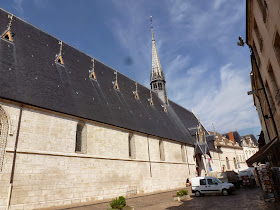












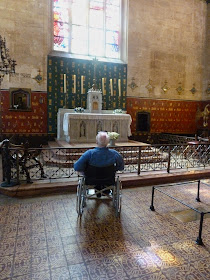
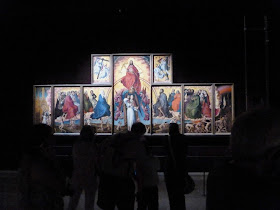























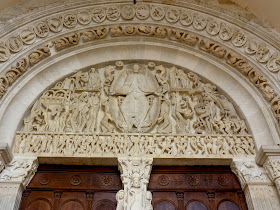
_-_WGA14829.jpg)

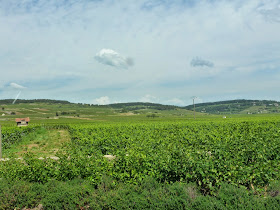









Thanks again for a wonderful tour by pictures. The colorful roofs are lovely, and the painting in the altarpiece at Hotel Dieu is exquisite. What an amazing place.
ReplyDeletePS: I forgot to say that I watched "The Monuments Men" last night and enjoyed it very much.
ReplyDeleteAh, now I know what I a "Hotel Dieu" is.
ReplyDeleteKnowing that, the pic of your traveling companion Bill P at the altar was very moving.